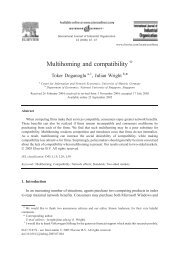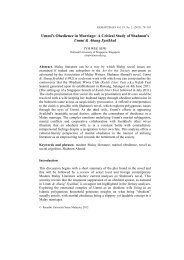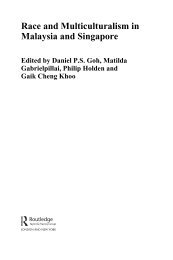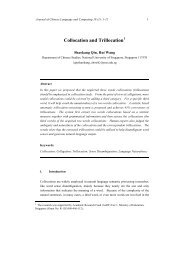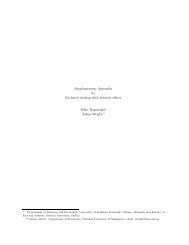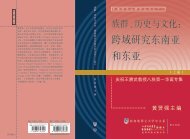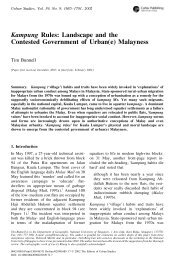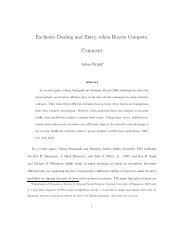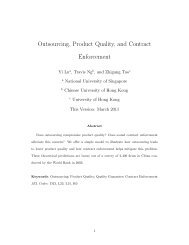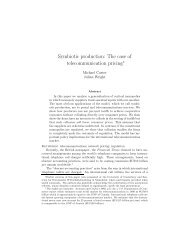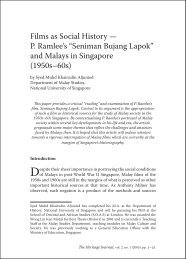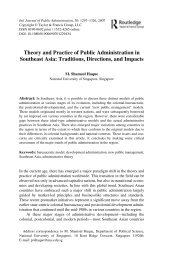Urban Studies - NUS - Home
Urban Studies - NUS - Home
Urban Studies - NUS - Home
You also want an ePaper? Increase the reach of your titles
YUMPU automatically turns print PDFs into web optimized ePapers that Google loves.
<strong>Urban</strong> <strong>Studies</strong><br />
http://usj.sagepub.com/<br />
Introduction: Global <strong>Urban</strong> Frontiers? Asian Cities in Theory, Practice and<br />
Imagination<br />
Tim Bunnell, Daniel P. S. Goh, Chee-Kien Lai and C. P. Pow<br />
<strong>Urban</strong> Stud 2012 49: 2785<br />
DOI: 10.1177/0042098012452454<br />
The online version of this article can be found at:<br />
http://usj.sagepub.com/content/49/13/2785<br />
Published by:<br />
http://www.sagepublications.com<br />
On behalf of:<br />
<strong>Urban</strong> <strong>Studies</strong> Journal Foundation<br />
Additional services and information for <strong>Urban</strong> <strong>Studies</strong> can be found at:<br />
Email Alerts: http://usj.sagepub.com/cgi/alerts<br />
Subscriptions: http://usj.sagepub.com/subscriptions<br />
Reprints: http://www.sagepub.com/journalsReprints.nav<br />
Permissions: http://www.sagepub.com/journalsPermissions.nav<br />
>> Version of Record - Sep 7, 2012<br />
What is This?<br />
Downloaded from usj.sagepub.com at NATIONAL UNIV SINGAPORE on November 30, 2012
49(13) 2785–2793, October 2012<br />
Introduction: Global <strong>Urban</strong> Frontiers?<br />
Asian Cities in Theory, Practice and<br />
Imagination<br />
Tim Bunnell, Daniel P. S. Goh, Chee-Kien Lai and C. P. Pow<br />
[Paper first received, May 2012; in final form, May 2012]<br />
Introduction: Asian <strong>Urban</strong>isms and<br />
the Frontiers of Knowledge<br />
There continues to be a disjuncture between<br />
the world’s shifting urban centre of gravity<br />
and the location of cities from which<br />
knowledge about our increasingly urban<br />
world is derived. On the one hand, according<br />
to recent UN-HABITAT figures, cities<br />
in the Asia-Pacific are now home to around<br />
half of the world’s urban population. In<br />
addition, 12 of the world’s 21 mega cities<br />
(defined as those with populations of 10<br />
million or more) are found in that region<br />
(UN-HABITAT, 2010). On the other hand,<br />
however, the cities which are taken as paradigmatic<br />
(most infamously Los Angeles in<br />
terms of post-modern urbanism) or as<br />
somehow leading edge (for example,<br />
London or New York as world cities in an<br />
era of economic globalisation) continue be<br />
concentrated in western Europe and North<br />
America (see also Edensor and Jayne, 2012).<br />
Clearly this is changing following influential<br />
calls to take seriously a greater diversity of<br />
cities from a wider range a regions in<br />
(re)theorising the urban (Robinson, 2006),<br />
or to foster ‘new geographies of theory’<br />
(Roy, 2009) in urban studies. This Special<br />
Issue is intended as a contribution to such<br />
changes in the geography of urban knowledge<br />
production, focusing in particular on<br />
experiences in/from Asia. How might that<br />
region’s position and significance in Anglophone<br />
urban studies be made more commensurate<br />
with the global distribution of<br />
urban settlements and populations?<br />
Tim Bunnell is in the Asia Research Institute and Department of Geography, National University of<br />
Singapore, 1 Arts Link, Kent Ridge, Singapore 117570, Singapore. E-mail: geotgb@nus.edu.sg.<br />
Daniel P. S. Goh is in the Department of Sociology, Faculty of Arts and Social Sciences, National<br />
University of Singapore, 11 Arts Link, Singapore 117570, Singapore. E-mail: socgohd@nus.edu.sg.<br />
Chee-Kien Lai is in the Department of Architecture, School of Design and Environment, National<br />
University of Singapore, 4 Architecture Drive, Singapore 117566. E-mail: akilaick@nus.edu.sg.<br />
C. P. Pow is in the Department of Geography, National University of Singapore, 1 Arts Link, Kent<br />
Ridge, Singapore 117570, Singapore. E-mail: geopowcp@nus.edu.sg.<br />
0042-0980 Print/1360-063X Online<br />
Ó 2012 <strong>Urban</strong> <strong>Studies</strong> Journal Limited<br />
DOI: 10.1177/0042098012452454<br />
Downloaded from usj.sagepub.com at NATIONAL UNIV SINGAPORE on November 30, 2012
2786 TIM BUNNELL ET AL.<br />
Seven of the nine articles collected here<br />
were first presented in a workshop which<br />
was held at the National University of<br />
Singapore’s Asia Research Institute (ARI) in<br />
September 2010. The title (of both the workshop<br />
and this Special Issue), ‘Global <strong>Urban</strong><br />
Frontiers’, may be elaborated in three ways.<br />
First, casting Asia in terms of urban frontiers<br />
is intended to resist the tendency to see cities<br />
in the region as following urban routes or<br />
pathways already trodden elsewhere. Cities<br />
and processes of urbanisation in Asia, in other<br />
words, are not reducible to supposed antecedents<br />
in North America, Western Europe or<br />
any other region. Secondly, use of the plural<br />
‘frontiers’ connotes the diversity of Asia and<br />
its cities. Leaving aside the issue of ‘Asia’ itself<br />
as a regional construct, we are certainly not<br />
positing the existence of some (singular)<br />
Asian city model or type. 1 Indeed, it is precisely<br />
because Asia includes differences that<br />
might ordinarily be held apart—cities of the<br />
global South and of the global North, megacities<br />
and global cities, ‘developed’ and ‘developing’<br />
worlds—that make it such a rich comparative<br />
frame (see also Robinson, 2011).<br />
Thirdly, and relatedly, to speak of ‘global’<br />
urban frontiers is a move intended to allow<br />
extension of insights from cities in Asia<br />
beyond the territorial confines of that region.<br />
Hence, the studies of cities in Asia that we are<br />
interested in are to be differentiated from conventionally<br />
bounded understandings of area<br />
studies. In line with the wider goals of the<br />
ARI Asian <strong>Urban</strong>isms research cluster which<br />
organised the September 2010 workshop, we<br />
therefore cast the diversity of Asia’s cities as a<br />
resource for urban knowledges that are of<br />
more-than-regional scope, significance and<br />
application.<br />
Relocating Asian Cities in Theory,<br />
Practice and Imagination<br />
Our compilation of papers examines cities<br />
in Asia as urban frontiers in three ways. The<br />
first has been alluded to already and concerns<br />
possibilities for cities in Asia to be sites<br />
for theorisation in academic urban studies.<br />
One way forward here, following Ananya<br />
Roy’s (2009) call to ‘rethink the list of<br />
‘‘great’’ cities’ in which urban theory production<br />
has been concentrated (she lists<br />
Chicago, New York, Paris and London), is<br />
to add or substitute in some Asian cities. In<br />
this case, it is important to think critically<br />
about the ways in which a city in Asia might<br />
be considered ‘great’. To the extent that criteria<br />
for qualification follow those that were<br />
also deemed to have made London or New<br />
York great cities—and it is important to<br />
stress that Roy herself is concerned precisely<br />
to move beyond established global city and<br />
world city hierarchies—new geographies of<br />
urban studies do not necessarily unsettle<br />
existing theoretical preoccupations or limitations.<br />
While inclusion of Shanghai or<br />
Mumbai may be welcomed in breaking a<br />
Euro-American monopoly on putatively<br />
great cities, in other words, this may also<br />
continue to privilege a small (albeit more<br />
widely distributed) number of metropolitan<br />
centres. In this way, hundreds of other cities<br />
(in Europe and North America, as well as in<br />
Asia and other regions of the world) are left<br />
‘off the map’ (Robinson, 2002), perpetuating<br />
a pervasive ‘metrocentricity’ (Bunnell<br />
and Maringanti, 2010). The point, then, is<br />
not to seek to identify great Asian cities, but<br />
to bring a greater number and diversity of<br />
cities from the region into the crucible of<br />
global urban knowledge production. In<br />
addition, it is important to note that the<br />
more-than-regional or ‘global’ theoretical<br />
scope of Asian urban locations is not merely<br />
a matter of their conformity to expectations<br />
of global city-ness or ‘globopolis’ (Douglass,<br />
2009), but also arises from other forms of<br />
‘worlding’ (Roy, 2009; Roy and Ong, 2011; -<br />
Simone, 2001), including academic practices<br />
of extending regionally situated insights to<br />
the theorisation of cities everywhere.<br />
Downloaded from usj.sagepub.com at NATIONAL UNIV SINGAPORE on November 30, 2012
INTRODUCTION TO SPECIAL ISSUE 2787<br />
This leads on to a second way in which<br />
Asian cities may be understood as frontiers<br />
of knowledge, concerning the practices<br />
through which they travel as models, lessons<br />
or exemplars. While this includes scholarly<br />
efforts at theory building from cities in<br />
Asia—Ananya Roy’s demonstration of how<br />
understandings of urban informality from<br />
Asia and other parts of the global South<br />
may be applied to all cities, including those<br />
in North America, being perhaps the clearest<br />
example to date (Roy, 2005, 2009)—a<br />
wide range of other urban authorities are<br />
also involved. Most prominent in recent<br />
social science literature have been policymakers,<br />
planning professionals and consultants<br />
associated with the mobility of urban<br />
best practices (see Peck and Theodore,<br />
2010, and the papers that their journal<br />
Special Issue introduces). Such work has<br />
brought to academic attention some supposedly<br />
leading edge cities that do not normally<br />
figure on global city lists—examples<br />
include Austin, TX, as a creative city (Peck,<br />
2005) and, as recently detailed in this journal,<br />
Bilbao and Barcelona as models of<br />
urban regeneration (Gonzalez, 2011).<br />
Although most such examples continue to<br />
be located in Europe or North America,<br />
there is also a growing body of work that<br />
recognises cities in Asia as ‘exporters’ of<br />
urban policy knowledge: greater Kuala<br />
Lumpur as an inspiration for ‘high-tech’<br />
development in Hyderabad (Bunnell and<br />
Das, 2010); and Singapore as an urban planning<br />
and development ‘model’ (Chua,<br />
2011). Colin McFarlane’s recent work on<br />
urban learning, meanwhile, highlights<br />
‘urban learning assemblages’ in the global<br />
South and shows that the translocalisation<br />
of urban knowledge involves social movements<br />
as well as academic, policy and planning<br />
professionals (McFarlane, 2011).<br />
Both academic theorisation of cities, and<br />
the wider practices through which they<br />
travel, arise from, and in turn generate,<br />
urban imaginations—the third of the ways<br />
in which Asian cities may be relocated as<br />
global urban frontiers. Cities in what<br />
Malcolm McKinnon (2011) refers to as<br />
‘developing Asia’ have, in common with<br />
much of the rest of the global South, conventionally<br />
been imagined in terms of problematic<br />
‘third world’ urbanisation. It is, in<br />
part, neo-orientalist lenses—restricting imaginings<br />
of cities in developing Asia to a<br />
stereotypical archive of slums, squalor and<br />
overcrowding—that have driven city and<br />
national governments to pursue ambitious<br />
urban re-imaging strategies (Bunnell,<br />
2004a). Of course, high-rise re-imaging<br />
undertaken in a city such as Kuala Lumpur<br />
(KL) may, at one level, be understood as an<br />
attempt to remake the Malaysian national<br />
capital in the image of global city frontiers<br />
that lie elsewhere, not least in New York<br />
City (Pile, 1999). Yet, irrespective of the success<br />
or failure of such ambitions, KL (or any<br />
other city) always exceeds prior global city<br />
pathways and is simultaneously worlded in<br />
a variety of other ways. In terms of ‘worlding<br />
from below’ (Simone, 2001), this might<br />
include the practices of migrant workers<br />
whose hands literally constructed KL’s<br />
would-be global city infrastructure and in<br />
whose heads imaginings of urban transformation<br />
are carried back to cities and villages<br />
elsewhere in the region (Nah and Bunnell,<br />
2005). In a very different way, KL has also<br />
emerged as an urban centre for the Islamic<br />
world, where affluent visitors from western<br />
Asia (the ‘Middle East’) can shop in style<br />
while never having to look far for halal food<br />
(Fischer, 2011). Youths in Malaysia itself,<br />
meanwhile, are more likely to follow ‘Seoul<br />
fashion’ than trends from Paris or Milan,<br />
not least because of the regional popularity<br />
of Korean film and television series that<br />
both depict and foster geographical imaginations<br />
of urban modernity that are not<br />
located in Europe or North America (Shim,<br />
2006, p. 29). 2<br />
Downloaded from usj.sagepub.com at NATIONAL UNIV SINGAPORE on November 30, 2012
2788 TIM BUNNELL ET AL.<br />
Overview of the Papers<br />
At least one of these ‘frontier’ conceptions<br />
of Asian cities runs through each of the<br />
nine papers that follow. However, the point<br />
is not to try to map particular papers, or<br />
the cities that they deal with, into one or<br />
more of the three heuristic categories that<br />
have already been elaborated. The first<br />
paper in this Special Issue is one that shows<br />
very clearly the complex intertwining of<br />
urban theory, practice and imagination.<br />
Colin McFarlane’s paper casts urban India<br />
as a theoretical frontier from or through<br />
which the vast literature on urban entrepreneurialism<br />
can be extended and rethought.<br />
Yet the cases that he details also reveal the<br />
mobile practices of a range of actors—civil<br />
society groups and ordinary citizens as well<br />
as the kinds of policy élites and consultants<br />
who have featured most prominently in the<br />
recent proliferation of work on travelling<br />
urban ideas and knowledges—and the<br />
effects of shifting imaginings of informal<br />
settlements in the minds of donors and<br />
politicians. Drawing largely upon work<br />
conducted in Mumbai over the past<br />
decade, McFarlane examines civil society<br />
groups as co-producers of forms of urban<br />
entrepreneurialism—and of associated<br />
models that travel—rather than as merely<br />
conduits for their enactment or implementation.<br />
Informal settlements are thus<br />
brought into view as a ‘‘key frontier in the<br />
production of contemporary urban entrepreneurialism’’<br />
(McFarlane, 2012: 2795)—<br />
sites from which the management and construction<br />
of toilet blocks as well as daily<br />
savings schemes emerge as model forms of<br />
‘slum activism’. However, McFarlane stresses<br />
that the activities of civil society organisations<br />
and slum residents are bound up<br />
with, without being reducible to, the<br />
(re)production of urban entrepreneurialism.<br />
It is this excess which means that slum<br />
dwellers’ activities and capacities ‘‘can also<br />
provide the scope for different possibilities<br />
beyond entrepreneurial formulations’’<br />
(McFarlane, 2012: 2812).<br />
Civil society activities are also a feature of<br />
the second paper, albeit in rather different<br />
ways from those elaborated by McFarlane in<br />
the context of urban India. Yong-Sook Lee<br />
and Eun-Jung Hwang provide an examination<br />
of creative city programmes in Seoul,<br />
South Korea. While cultural industries are a<br />
longstanding feature of economic development<br />
strategies in Seoul, Lee and Hwang are<br />
concerned in particular with the political<br />
period that began when Oh Se-hoon became<br />
mayor in 2006. Mayor Oh went on study<br />
tours to model ‘creative’ cities, mostly in<br />
western Europe, and subsequently began to<br />
promote Seoul as a model in its own right—<br />
mostly for other cities in Asia. However,<br />
what might uncritically be read as a creative<br />
city model or policy frontier is cast by Lee<br />
and Hwang as a largely unmerited quest for<br />
political legitimacy. Nonetheless, Lee and<br />
Hwang hold out the hope that critique from<br />
South Korea’s vibrant civil society can help<br />
to redirect Seoul’s creative city strategies<br />
away from the current focus on construction<br />
of physical infrastructure and making the<br />
city attractive to tourists, and towards the<br />
realisation of a more open, tolerant and<br />
democratic city.<br />
The subsequent two papers each, in different<br />
ways, evaluate Singapore as a model<br />
for, or leading edge of, global urban transformation.<br />
In the case of Erica Yap’s paper,<br />
the focus is a giant observation wheel,<br />
known as the Singapore Flyer, which<br />
opened to the public in 2008. Although the<br />
Singapore Flyer (deliberately) eclipsed the<br />
height of an earlier wheel in London, Yap<br />
shows that it is the London Eye which is<br />
more frequently referenced by cities looking<br />
to build wheels of their own. For Yap,<br />
this connotes a failure of the project to supplant<br />
London in global imaginaries, just as<br />
Seoul (as elaborated by Lee and Hwang)<br />
Downloaded from usj.sagepub.com at NATIONAL UNIV SINGAPORE on November 30, 2012
INTRODUCTION TO SPECIAL ISSUE 2789<br />
has struggled to position itself as a model<br />
creative city. Zhang Jun’s paper, in contrast,<br />
details a case in which Singapore has<br />
been enthusiastically embraced as a model.<br />
Shenzhen, itself very much at the leading<br />
edge of China’s capitalist transformation,<br />
was shaped through dozens of overseas<br />
study tours conducted from the late 1970s.<br />
Initially, the plan was for Shenzhen to<br />
undergo ‘Hongkongisation’, but Singapore<br />
gradually replaced Hong Kong as the<br />
favourite source of ‘policy borrowing’.<br />
Whether or not Singapore should be seen as<br />
best practice is a moot point. Zhang suggests<br />
that, in the case of Chinese policy<br />
élites, Singapore’s allure derived largely<br />
from its state-controlled authoritarianism,<br />
but certainly this is a case where it is a city<br />
in Asia, rather than in Europe or North<br />
America, that is deemed to be exemplary.<br />
There follow two papers which examine<br />
the recent transformation of Phnom Penh,<br />
Cambodia. Tom Percival and Paul Waley<br />
focus specifically on the private-sector<br />
development of satellite cities in peri-urban<br />
areas. These are differentiated from gated<br />
communities (which have also received<br />
considerable attention in studies of Asian<br />
cities—see, for example, Pow, 2009; Hogan<br />
et al., 2012) in that satellite cities tend to be<br />
larger and incorporate commercial and leisure<br />
as well as residential functions.<br />
Significantly, the developments that Percival<br />
and Waley describe are being driven by<br />
capital and models from within the Asian<br />
region. Again, Singapore is involved (in the<br />
form of master planning consultants), but<br />
the main players in real estate development<br />
are from Indonesia and South Korea. In the<br />
latter case, Phnom Penh was one of various<br />
(peri-)urban frontiers extended by companies<br />
which had outgrown the domestic<br />
real estate market in South Korea. Willem<br />
Paling, in his contribution to the Special<br />
Issue, complicates the picture of intra-<br />
Asian private-sector-led transformation in<br />
Phnom Penh by considering other actors,<br />
including international donors and highlevel<br />
politicians. A French development-aidfunded<br />
master plan intended to guide public<br />
and private development in Phnom Penh<br />
until 2020 has been thwarted by privatesector<br />
projects that emerge from opaque—<br />
and, it should be noted, very difficult to<br />
research—political networks and patronage<br />
systems. The private-sector developments<br />
that have refashioned the urban landscape of<br />
the Cambodian capital, therefore, need to be<br />
understood in a wider political context—one<br />
characterisedbyhighlycentraliseddecisionmaking<br />
power but also very limited state<br />
capacity to guide or restrict metropolitan<br />
developmental processes.<br />
State practices and imaginings are also<br />
foregrounded in the next two contributions<br />
to the Special Issue, on the cities of Putrajaya<br />
and Macao respectively. In the case of<br />
Putrajaya, Malaysia’s recently constructed<br />
federal government administrative centre,<br />
Sarah Moser shows how the urban landscape<br />
may be read in terms of Malay political<br />
élites’ conceptions of Islam and national<br />
identity. If the transformation of the skyline<br />
of the national capital, Kuala Lumpur, in<br />
the 1990s was about projecting an image of<br />
modern Malaysia (see also Bunnell, 2004b),<br />
Moser understands Putrajaya as an expression<br />
of ‘High Islam’ in the form of ‘fantasy<br />
Middle Eastern architecture’. The latter is<br />
not so much about positioning Malaysia’s<br />
main urban region in a hierarchy topped<br />
by London or New York, but imaginatively<br />
locates Putrajaya (and Malaysia more<br />
broadly) in an Islamic world centred in the<br />
Middle East. The ‘success’ of the Putrajaya’s<br />
High Islam aesthetic is such that it has<br />
joined Singapore as a regional model for<br />
urban development, with Indonesia’s Island<br />
Riau Province boasting of its new provincial<br />
capital (Dompak) as ‘The Singapore<br />
and Putrajaya of Tanjung Pinang’. In contrast,<br />
Chin-Ee Ong and Hilary du Cros<br />
Downloaded from usj.sagepub.com at NATIONAL UNIV SINGAPORE on November 30, 2012
2790 TIM BUNNELL ET AL.<br />
note that the city of Macao has often been<br />
referred to as ‘the Las Vegas of the East’.<br />
The archetypal gambling city is in the state<br />
of Nevada in the US, not a Special Administrative<br />
Region of China, despite the fact<br />
that Macao’s gambling revenues are now<br />
more than double those of Las Vegas. However,<br />
Ong and du Cros’ concern is not to<br />
invert the comparative gesture—making<br />
Las Vegas ‘the Macao of the West’—but,<br />
rather, to examine the multiple worlds<br />
within which images of Macao circulate.<br />
Focusing in particular on the Shanghai<br />
Expo of 2010, Ong and du Cros show that<br />
the Macao Pavilion was as much about<br />
negotiating the Special Administrative<br />
Region’s national political position as a<br />
recently incorporated part of PRC, as it was<br />
about showcasing images for the consumption<br />
of would-be investors, gamblers or<br />
other visitors.<br />
In the final paper in the Special Issue,<br />
Andrew Harris returns to where Colin<br />
McFarlane began in the first paper:<br />
Mumbai. It is somewhat ironic, therefore,<br />
that Harris’ paper is a critical reflection on<br />
the considerable popular and academic<br />
attention afforded to Mumbai in recent<br />
years. In academic terms, Mumbai has<br />
emerged as one of the cities at the forefront<br />
of a ‘Southern turn’ in urban studies. As<br />
Harris points out, even Ed Soja—well<br />
known for having suggested that Los<br />
Angeles is where it ‘all comes together’—<br />
has listed Mumbai (along with Shanghai,<br />
Delhi and Singapore) as Asian cities from<br />
which Eurocentred city studies have much<br />
to learn. While the growing attention to<br />
cities beyond the Euro-American heartlands<br />
of academic knowledge production is<br />
to be welcomed, Harris cautions against<br />
celebrating Mumbai’s growing prominence<br />
in Anglophone urban studies. In particular,<br />
he argues that it is important to be mindful<br />
of how Mumbai is attended to, engaged<br />
with and represented. All too often, Mumbai<br />
is apprehended as a global city, with the<br />
result that large areas of the city—with associated<br />
histories and grounded realities—are<br />
overlooked. Put another way, Mumbai is<br />
largely engaged with in ways that fit existing<br />
Euro-American experiences and Anglophone<br />
vocabularies rather than in ways that<br />
serve to unsettle them.<br />
Global <strong>Urban</strong> Frontiers?<br />
There is one minor, but important, difference<br />
between the title of the workshop<br />
where seven of the papers that follow were<br />
first presented—the exceptions being the<br />
papers by Erica Yap and by Sarah Moser—<br />
and the title of this Special Issue: namely,<br />
the addition of a question mark after the<br />
main part of the title. This addition is<br />
prompted by a questioning of the term’s<br />
suitability for the cases that are detailed in<br />
the contributions that follow. The paper<br />
which questions the suitability of ‘global<br />
urban frontiers’ most explicitly is Yong-<br />
Sook Lee and Eun-Jung Hwang’s article on<br />
Seoul, although they are working with a specific<br />
understanding of frontier in relation to<br />
the advancement of a particular urban<br />
policy type. Lee and Hwang’s own article is<br />
evidence that it is possible to advance frontiers<br />
of critical urban studies knowledge<br />
about creative cities from a contextually<br />
rich analysis of a city in Asia, even if the<br />
leading edge of creative city policy and practice<br />
remains elsewhere. Here, we might usefully<br />
evoke Kuan-Hsing Chen’s conception<br />
of Asia as ‘method’ (Chen, 2010). In his<br />
‘geocolonial’ critique of Soja’s discussion of<br />
Los Angeles, Chen (2010, p. 107) asks ‘what<br />
differences might have been produced’ had<br />
the reference points of post-modern urban<br />
space been Asian cities, rather than LA? For<br />
us, this provokes further questions: why<br />
specifically Asian cities or only Asian cities?<br />
And, which cities in Asia? We can begin to<br />
Downloaded from usj.sagepub.com at NATIONAL UNIV SINGAPORE on November 30, 2012
INTRODUCTION TO SPECIAL ISSUE 2791<br />
answer the first of these questions by returning<br />
to the notion that Asia remains a relatively<br />
untapped region for urban theory<br />
production, and one which includes urban<br />
diversity that is often held apart by regional<br />
or area studies partitioning of the world.<br />
Yet we could perhaps point to other frontier<br />
geographies, including North America:<br />
surely different insights would also have<br />
been produced if the reference point was<br />
Lexington, Kentucky, rather than LA (see<br />
McCann, 2004). In other words, Asian cities<br />
may be located as ‘global urban frontiers’,<br />
but this is not to suggest that Asia has a<br />
monopoly on the resources for urban<br />
(re)theorisation.<br />
As for the second question concerning<br />
‘which cities?’, we re-emphasise the importance<br />
of acknowledging and embracing<br />
Asia’s urban diversity—Asian urbanisms<br />
(plural). The point is not to substitute LA<br />
with Seoul or Phnom Penh or Mumbai—as<br />
Andrew Harris warns us in this Special<br />
Issue—but to see Asia’s urban diversity as a<br />
shifting theoretical frontier. If Mumbai<br />
becomes the new LA, then it may be time to<br />
examine elsewhere in urban Maharashtra or<br />
cities in other states in India, or in other<br />
countries in the region; and then, perhaps,<br />
to use these experiences to enable a critical<br />
comparative relook at Mumbai itself (see<br />
Robinson, 2011). The articles collected in<br />
this Special Issue thus form part of an ongoing<br />
process of pushing the frontiers by<br />
bringing more of urban Asia into the comparative<br />
crucible of global urban knowledge.<br />
In geographical terms, the frontiers may be<br />
extended through examination of smaller<br />
cities than most of those that feature here (see<br />
also Roy, 2011; Chen and Kanna, 2012), especially<br />
given that the majority of the world’s<br />
urban population live in cities with less than<br />
one million inhabitants (UNFPA, 2007, p.<br />
10). Another way would be to incorporate<br />
insights from other parts of ‘Asia’—the postcolonial<br />
urban projects of central Asia (see<br />
Koch, forthcoming), for example, or the Gulf<br />
cities of South-west Asia (Mohammad and<br />
Sidaway, 2012). Finally, perhaps the most<br />
important frontiers of knowledge from a<br />
region in which half of the world’s urban<br />
population live, are those which attend to the<br />
small, everyday and yet often worldly initiatives<br />
of ordinary people (Simone, 2010).<br />
Notes<br />
1. It is in this way that our orientation may be<br />
contrasted with earlier attempts to distinguish<br />
regionally specific typologies of cities<br />
from experiences in the West (for example,<br />
McGee, 1967). It is also for this reason that<br />
Peter Rimmer and Howard Dick recently<br />
made the explicit distinction between ‘the<br />
city in South-east Asia’ and ‘the South-east<br />
Asian city’ (Rimmer and Dick, 2009).<br />
2. This serves to re-emphasise the point that<br />
the region includes not only ‘developing<br />
Asia’ and cities that are often framed in<br />
terms of the global South, but also cities<br />
such as Seoul and Tokyo that are commonly<br />
ranked among the upper tiers of global city<br />
hierarchies. Of course, many cities in the<br />
region – including Kuala Lumpur – may also<br />
be understood as straddling such divides.<br />
Funding Statement<br />
The Guest Editors gratefully acknowledge funding<br />
from the Asia Research Institute (ARI) and<br />
from the Global Asia Institute at the National<br />
University of Singapore that made possible the<br />
workshop at which most of these papers were<br />
first presented.<br />
Acknowledgements<br />
Thanks to Sharon Ong and other members of<br />
ARI’s events organisation team for excellent<br />
administrative support at the Global <strong>Urban</strong><br />
Frontiers workshop. The Guest Editors are grateful<br />
also for editorial encouragement and helpful<br />
comments from Ronan Paddison as well as for<br />
the friendly editorial efficiency of Ruth Harkin.<br />
Downloaded from usj.sagepub.com at NATIONAL UNIV SINGAPORE on November 30, 2012
2792 TIM BUNNELL ET AL.<br />
References<br />
Bunnell, T. (2004a) Re-viewing the entrapment<br />
controversy: megaprojection, (mis)representation<br />
and postcolonial performance, Geo-<br />
Journal, 59, pp. 297–305.<br />
Bunnell, T. (2004b) Malaysia, Modernity and<br />
the Multimedia Super Corridor: A Critical<br />
Geography of Intelligent Landscapes. London:<br />
RoutledgeCurzon.<br />
Bunnell, T. and Das, D. (2010) <strong>Urban</strong> pulse: a<br />
geography of serial seduction: urban policy<br />
transfer from Kuala Lumpur to Hyderabad,<br />
<strong>Urban</strong> Geography, 31, pp. 277–284.<br />
Bunnell, T. and Maringanti, A. (2010) Practising<br />
urban regional research beyond metrocentricity,<br />
International Journal of <strong>Urban</strong> and<br />
Regional Research, 34, pp. 415–420.<br />
Chen, K.-H. (2010) Asia as Method: Toward<br />
Deimperialization. Durham, NC: Duke University<br />
Press.<br />
Chen, X. and Kanna, A. (Eds) (2012) Rethinking<br />
Global <strong>Urban</strong>ism: Comparative Insights from<br />
Secondary Cities. London: Routledge.<br />
Chua, B. H. (2011) Singapore as model, in: A.<br />
Roy and A. Ong (Eds) Worlding Cities: Asian<br />
Experiments and the Art of Being Global, pp.<br />
29–54. Oxford: Wiley Blackwell.<br />
Douglass, M. (2009) Globopolis or cosmopolis?<br />
Alternative futures of city life in East Asia,<br />
<strong>Studies</strong> in <strong>Urban</strong> Humanities, 2, pp. 67–115.<br />
Edensor, T. and Jayne, M. (Eds) (2012) <strong>Urban</strong><br />
Theory beyond the West: A World of Cities.<br />
London: Routledge.<br />
Fischer, J. (2011) The Halal Frontier: Muslim<br />
Consumers in a Globalized Market. New York:<br />
Palgrave Macmillan.<br />
Gonzalez, S. (2011) Bilbao and Barcelona ‘in<br />
motion’: how urban regeneration ‘models’<br />
travel and mutate in the global flows of policy<br />
tourism, <strong>Urban</strong> <strong>Studies</strong>, 48, pp. 1397–1418.<br />
Hogan, T., Bunnell, T., Pow, C. P., Permanasari, E.<br />
and Morshidi, S. (2012) Asian urbanisms and<br />
the privatization of cities, Cities, 29, pp. 59–63.<br />
Koch, N. (forthcoming) A model for Astana?<br />
Centres, peripheries, and tall towers, <strong>Urban</strong><br />
Geography.<br />
McCann, E. (2004) <strong>Urban</strong> political economy<br />
beyond the ‘global city’, <strong>Urban</strong> <strong>Studies</strong>, 41,<br />
pp. 2315–2334.<br />
McFarlane, C. (2011) Learning the City: Knowledge<br />
and Translocal Assemblage. Chichester:<br />
John Wiley and Sons.<br />
McFarlane, C. (2012) The entrepreneurial slum:<br />
civil society, mobility, and the co-production<br />
of urban development, <strong>Urban</strong> <strong>Studies</strong>, 49(13),<br />
pp. 2795–2816.<br />
McGee, T. G. (1967) The Southeast Asian City:<br />
A Social Geography of the Primate Cities of<br />
Southeast Asia. London: Bell.<br />
McKinnon, M. (2011) Asian Cities: Globalization,<br />
<strong>Urban</strong>ization and Nation-building. Copenhagen:<br />
NIAS Press.<br />
Mohammad, R. and Sidaway, J. D. (2012) Spectacular<br />
urbanization amidst variegated geographies<br />
of globalization: learning from Abu<br />
Dhabi’s trajectory through the lives of South<br />
Asian men, International Journal of <strong>Urban</strong> and<br />
Regional Research, 36, pp. 606–627.<br />
Nah, A. M. and Bunnell, T. (2005) Ripples of<br />
hope: Acehnese refugees in post-tsunami<br />
Malaysia, Singapore Journal of Tropical Geography,<br />
26, pp. 249–256.<br />
Peck, J. (2005) Struggling with the creative class,<br />
International Journal of <strong>Urban</strong> and Regional<br />
Research, 24, pp. 740–770.<br />
Peck, J. and Theodore, N. (2010) Mobilizing<br />
policy: models, methods and mutations, Geoforum,<br />
41, pp. 169–174.<br />
Pile, S. (1999) What is a city?, in: D. Massey, J.<br />
Allen and S. Pile (Eds) City Worlds, pp. 3–52.<br />
London: Routledge.<br />
Pow, C.-P. (2009) Gated Communities in China:<br />
Class, Privilege and the Moral Politics of the<br />
Good Life. London: Routledge.<br />
Rimmer,P.J.andDick,H.(2009)The City in Southeast<br />
Asia: Patterns, Processes and Policy. Singapore:<br />
National University of Singapore Press.<br />
Robinson, J. (2002) Global cities: a view from off<br />
the map, International Journal of <strong>Urban</strong> and<br />
Regional Research, 26, pp. 531–534.<br />
Robinson, J. (2006) Ordinary Cities: Between Modernity<br />
and Development. Abingdon: Routledge.<br />
Robinson, J. (2011) Cities in a world of cities: the<br />
comparative gesture, International Journal of<br />
<strong>Urban</strong> and Regional Research, 35(1), pp. 1–23.<br />
Roy, A. (2005) <strong>Urban</strong> informality: towards an<br />
epistemology of planning, Journal of the<br />
American Planning Association, 71(2), pp.<br />
147–158.<br />
Downloaded from usj.sagepub.com at NATIONAL UNIV SINGAPORE on November 30, 2012
INTRODUCTION TO SPECIAL ISSUE 2793<br />
Roy, A. (2009) The 21st-century metropolis: new<br />
geographies of theory, Regional <strong>Studies</strong>, 43,<br />
pp. 819–830.<br />
Roy, A. (2011) <strong>Urban</strong>isms, worlding practices<br />
and the theory of planning, Planning Theory,<br />
10, pp. 6–15.<br />
Roy, A. and Ong, A. (Eds) (2011) Worlding<br />
Cities: Asian Experiments and the Art of being<br />
Global. Oxford: Wiley Blackwell.<br />
Shim, D. (2006) Hybridity and the rise of Korean<br />
popular culture in Asia, Media, Culture and<br />
Society, 28, pp. 25–44.<br />
Simone, A. (2001) On the worlding of African<br />
cities, African <strong>Studies</strong> Review, 44, pp. 15–41.<br />
Simone, A. (2010) City Life from Jakarta to<br />
Dakar: Movements at the Crossroads. New<br />
York: Routledge.<br />
UN-HABITAT (2010) The state of Asian cities<br />
2010/11. United Nations Human Settlements<br />
Programme, Fukuoka.<br />
UNFPA (United Nations Population Fund)<br />
(2007) State of world population, 2007:<br />
unleashing the potential of urban growth<br />
(http://www.unfpa.org/swp/2007/presskit/pdf/<br />
sowp2007_eng.pdf).<br />
Downloaded from usj.sagepub.com at NATIONAL UNIV SINGAPORE on November 30, 2012



